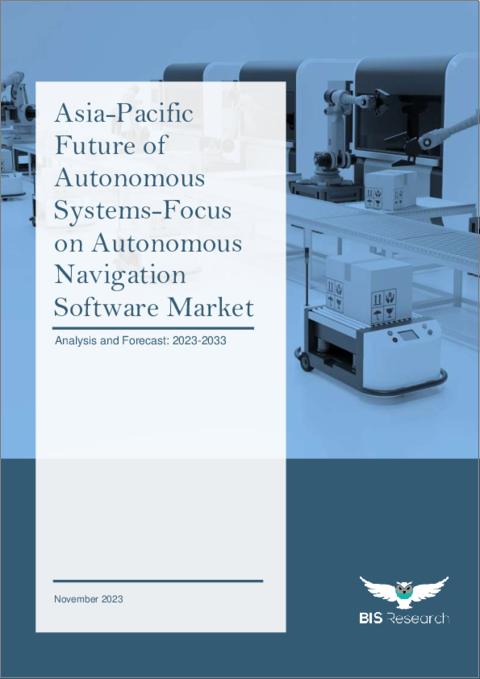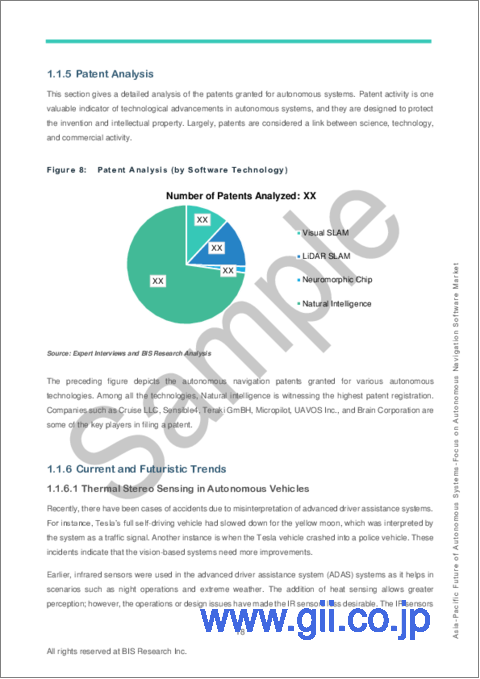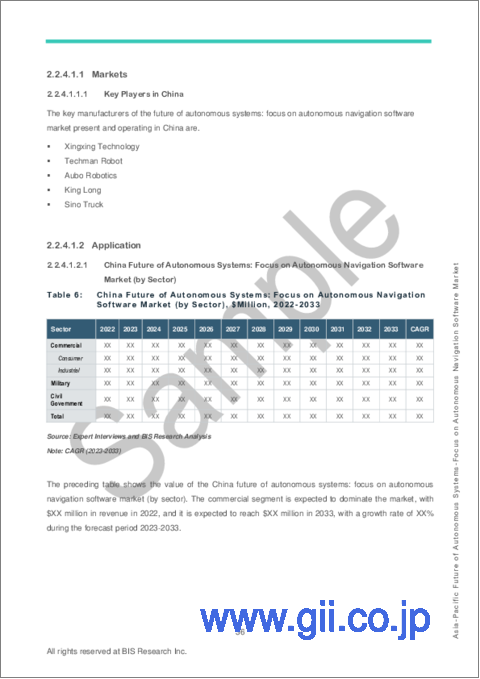|
|
市場調査レポート
商品コード
1385465
アジア太平洋の軍事用ロボット・自律システム(RAS)市場 - 分析と予測(2023年~2033年)Asia-Pacific Military Robotic and Autonomous System (RAS) Market - Analysis and Forecast, 2023-2033 |
||||||
カスタマイズ可能
|
|||||||
| アジア太平洋の軍事用ロボット・自律システム(RAS)市場 - 分析と予測(2023年~2033年) |
|
出版日: 2023年11月24日
発行: BIS Research
ページ情報: 英文 79 Pages
納期: 1~5営業日
|
- 全表示
- 概要
- 図表
- 目次
アジア太平洋の軍事用ロボット・自律システム(RAS)の市場規模は、2022年に31億5,650万米ドルと評価され、2023年から2033年の予測期間中に2.54%のCAGRで拡大し、2033年末までに41億5,280万米ドルに達すると予測されています。
人工知能(AI)はアジアにおける軍事用RAS市場拡大の主要因であり、軍事用RASとの組み合わせは将来の戦争を一変させる可能性を秘めています。兵士、空軍、海兵隊が直面する危険の低減を支援し、将来的にはよりコストの低い有人システムの開発につながる可能性があります。軍事ロボット・自律システムの開発における3大ライバルは、米国、ロシア、中国です。国防予算が潤沢な主要国の軍隊は、軍隊の短期、中期、長期の目標を明記した計画に集中しています。
| 主要市場統計 | |
|---|---|
| 予測期間 | 2023年~2033年 |
| 2023年評価 | 32億3,240万米ドル |
| 2033年予測 | 41億5,280万米ドル |
| CAGR | 2.54% |
アジア太平洋(APAC)の軍事用ロボット・自律システム(RAS)市場は、最先端技術を駆使して防衛能力を強化することに重点が置かれるようになっているため、急速なペースで拡大しています。複雑でダイナミックな安全保障状況における作戦効率、偵察、監視の強化が求められていることが、アジア太平洋の市場力学市場を牽引しています。APAC諸国は、地政学的緊張が続き、軍事近代化の取り組みが加速するにつれて、空中ドローン、地上ロボット、自律走行車などの無人技術への投資を増やしています。これらのシステムは、全体的な作戦遂行能力の向上、危険な状況下での人的リスクの低減、リアルタイムの情報供給、軍事能力の強化に不可欠です。継続的な技術開拓と防衛機関と企業間の提携が、APAC軍事用RAS市場の成長を当面さらに促進すると予想されます。
当レポートでは、アジア太平洋の軍事用ロボット・自律システム(RAS)市場について調査し、市場の概要とともに、用途別、プラットフォーム別、国別の動向、および市場に参入する企業のプロファイルなどを提供しています。
目次
第1章 市場
- 業界の見通し
- ビジネスダイナミクス
- 事業戦略
第2章 アジア太平洋
- 軍事用ロボット・自律システム(RAS)市場(地域別)
- アジア太平洋
第3章 市場-競合ベンチマーキングと企業プロファイル
- 競合ベンチマーキング
- 主要な市場参入企業
- Defence Research and Development Organisation (DRDO)
- 無人地上およびロボットシステム市場の主要参入企業
- Hanwha Defense
第4章 調査手法
List of Figures
- Figure 1: Military Robotic and Autonomous (RAS) Market, $Million, 2022-2033
- Figure 2: Military Robotic and Autonomous System (RAS) Market, Volume, 2022-2033
- Figure 3: Military Robotic and Autonomous System (RAS) Market (by Application), $Million, 2022 and 2033
- Figure 4: Military Robotic and Autonomous System (RAS) Market (by Application), Volume, 2022 and 2033
- Figure 5: Military Robotic and Autonomous System (RAS) Market (by Platform), $Million, 2022 and 2033
- Figure 6: Military Robotic and Autonomous System (RAS) Market (by Platform), Volume, 2022 and 2033
- Figure 7: Military Robotic and Autonomous System (RAS) Market (by Operation Mode), $Million, 2022 and 2033
- Figure 8: Military Robotic and Autonomous Systems (RAS) Market (by Operation Mode), Volume, 2022 and 2033
- Figure 9: Military Robotic and Autonomous System (RAS) Market (by Region), $Million, 2033
- Figure 10: Patent Analysis, 2020-2022
- Figure 11: Supply Chain Analysis of the Military Robotic and Autonomous System (RAS) Market
- Figure 12: Military Robotic and Autonomous System (RAS) Market, Business Dynamics
- Figure 13: Defense Budget, 2020 and 2021
- Figure 14: Military Robotic and Autonomous System Market Players, Benchmarking Score, 2022
- Figure 15: Research Methodology
- Figure 16: Top-Down and Bottom-Up Approach
- Figure 17: Assumptions and Limitations
List of Tables
- Table 1: Military Robotic and Autonomous Systems Contracts, January 2021-January 2023
- Table 2: Partnerships, Collaborations, Agreements, and Contracts, January 2021-January 2023
- Table 3: Mergers and Acquisitions, January 2021-January 2023
- Table 4: Military Robotic and Autonomous System (RAS) Market (by Region), $Million, 2022-2033
- Table 5: Asia-Pacific Military Robotic and Autonomous System (RAS) Market (by Application), $Million, 2022-2033
- Table 6: Asia-Pacific Military Robotic and Autonomous System (RAS) Market (by Platform), $Million, 2022-2033
- Table 7: China Military Robotic and Autonomous System (RAS) Market (by Application), $Million, 2022-2033
- Table 8: China Military Robotic and Autonomous System (RAS) Market (by Platform), $Million, 2022-2033
- Table 9: India Military Robotic and Autonomous System (RAS) Market (by Application), $Million, 2022-2033
- Table 10: India Military Robotic and Autonomous System (RAS) Market (by Platform), $Million, 2022-2033
- Table 11: Japan Military Robotic and Autonomous System (RAS) Market (by Application), $Million, 2022-2033
- Table 12: Japan Military Robotic and Autonomous System (RAS) Market (by Platform), $Million, 2022-2033
- Table 13: South Korea Military Robotic and Autonomous System (RAS) Market (by Application), $Million, 2022-2033
- Table 14: South Korea Military Robotic and Autonomous System (RAS) Market (by Platform), $Million, 2022-2033
- Table 15: Rest-of-Asia-Pacific Military Robotic and Autonomous System (RAS) Market (by Application), $Million, 2022-2033
- Table 16: Rest-of-Asia-Pacific Military Robotic and Autonomous System (RAS) Market (by Platform), $Million, 2022-2033
- Table 17: Benchmarking and Weightage Parameters
- Table 18: Defence Research and Development Organisation: Product Portfolio
- Table 19: Hanwha Defense: Product and Service Portfolio
- Table 20: Hanwha Defense: Partnerships, Collaborations, Agreements, Investments, and Mergers and Acquisitions
“The Asia-Pacific Military Robotic and Autonomous System (RAS) Market Expected to Reach $4,152.8 Million by 2033.”
Introduction to Asia-Pacific Military Robotic and Autonomous System (RAS) Market
In 2022, the Asia-Pacific military RAS market was valued at $3,156.5 million and is expected to reach $4,152.8 million by the end of 2033, growing at a CAGR of 2.54% during the forecast period 2023-2033. Artificial intelligence (AI) has been a major factor in the expansion of the military RAS market in Asia, and its combination with military RAS has the potential to transform warfare in the future. It will assist in lowering the hazards that soldiers, air forces, and marines face, which could lead to the development of manned systems that are less costly in the future. The three main rivals in the development of military robotic and autonomous systems are the United States, Russia, and China. The military of major nations with substantial defense budgets is concentrating on plans that specify the short-, medium-, and long-term objectives of their armed forces.
| KEY MARKET STATISTICS | |
|---|---|
| Forecast Period | 2023 - 2033 |
| 2023 Evaluation | $3,232.4 Million |
| 2033 Forecast | $4,152.8 Million |
| CAGR | 2.54% |
Market Introduction
The military robotic and autonomous system (RAS) market in Asia-Pacific (APAC) is expanding at a rapid pace due to the region's growing emphasis on bolstering defense capabilities by using cutting-edge technologies. The requirement for enhanced operational efficiency, reconnaissance, and surveillance in complex and dynamic security situations is what is driving the market for Military RAS in the Asia-Pacific region. APAC countries are investing more in unmanned technologies, such as aerial drones, ground robots, and autonomous vehicles, as geopolitical tensions continue and military modernization efforts pick up speed. These systems are essential for improving overall operational performance, lowering human risk in dangerous situations, supplying real-time intelligence, and strengthening military capabilities. Continuous technical development and partnerships between defense agencies and business entities are anticipated to further propel the growth of the APAC Military RAS market in the foreseeable future.
Market Segmentation:
Segmentation 1: by Application
- Intelligence, Surveillance, and Reconnaissance (ISR)
- Combat Operation
- Target Acquisition
- Logistics
- Mine Clearance, Explosive Ordnance Disposal (EOD), and Chemical, Biological, Radiological, and Nuclear (CBRN)
- Infantry Support
- Others
Segmentation 2: by Platform
- Unmanned Aircraft Systems
- Unmanned Ground and Robotic Systems
- Unmanned Maritime Systems
Segmentation 3: by Country
- China
- India
- Japan
- South Korea
- Rest-of-Asia-Pacific
How can this report add value to an organization?
Product/Innovation Strategy: The product segment aids the reader in understanding the different types of military RAS and their potential in Asia-Pacific region. Additionally, the study provides the reader with a detailed understanding of the different military RAS based on application (intelligence, surveillance, & reconnaissance (ISR), combat operation, target acquisition, logistics, mine clearance, EOD, CBRN, infantry support and others), platform (UAS (MALE UAVs, HALE UAVs, UCAVs, unmanned helicopters, small UAVs, loitering munition UAVs), UGRS (UGVs, robots, humanoid robots), UMS (autonomous maritime surface vehicles, autonomous maritime underground vehicles)), operation mode (UAS (autonomous, semi-autonomous), UGRS (autonomous, semi-autonomous), UMS (autonomous, semi-autonomous)).
Growth/Marketing Strategy: The Asia-Pacific military RAS market has witnessed major development by key players operating in the market, such as business expansion, contracts, mergers, partnerships, collaborations, and joint ventures. The favored strategy for the companies has been contracts, enabling them to strengthen their positions in the Asia-Pacific military RAS market.
Competitive Strategy: The key players in the Asia-Pacific military RAS market analyzed and profiled in the study involve military RAS manufacturers. Moreover, a detailed competitive benchmarking of the players operating in the Asia-Pacific military RAS market has been done to help the reader understand how players stack against each other, presenting a clear market landscape. Additionally, comprehensive competitive strategies such as contracts, partnerships, agreements, acquisitions, and collaborations will aid the reader in understanding the untapped revenue pockets in the market.
Key Market Players and Competition Synopsis
The companies that are profiled have been selected based on inputs gathered from primary experts and analysing company coverage, product portfolio, and market penetration.
Some of the prominent names established in this market are:
|
|
Table of Contents
1 Markets
- 1.1 Industry Outlook
- 1.1.1 Military Robotic and Autonomous System (RAS) Market: An Overview
- 1.1.2 Current and Emerging Technological Trends
- 1.1.3 On-going and Upcoming Projects: Major Military Programs
- 1.1.4 Startup and Investment Landscape
- 1.1.5 Patent Analysis (2020-2022)
- 1.1.6 Supply Chain Analysis
- 1.2 Business Dynamics
- 1.2.1 Business Drivers
- 1.2.1.1 Growing Need for Enhancing Battlefield Situational Awareness
- 1.2.1.2 Growing Defense Budget
- 1.2.1.3 Rising Demand for Reducing Human Involvement in Battlefield Activities
- 1.2.1.4 Generating Mass and Scalable Effects through Human-Machine Teaming
- 1.2.2 Business Challenges
- 1.2.2.1 Evolving Cyberthreats to Military Robotic and Autonomous Systems
- 1.2.2.2 Challenges Related to Deployment of Complex Systems and Control Frameworks
- 1.2.2.3 Contractor Challenges and Supplier Issues in Final Delivery of Military Robotic and Autonomous Systems
- 1.2.3 Business Opportunities
- 1.2.3.1 Increasing Innovations in the Field of Artificial Intelligence (AI)
- 1.2.3.2 Growing Threat Perception due to Ukraine-Russia Conflict Driving Missile Defense Spending
- 1.2.1 Business Drivers
- 1.3 Business Strategies
- 1.3.1 Partnerships, Collaborations, Agreements, and Contracts
- 1.3.2 Mergers and Acquisitions
2 Asia-Pacific
- 2.1 Military Robotic and Autonomous System (RAS) Market (by Region)
- 2.2 Asia-Pacific
- 2.2.1 Market
- 2.2.1.1 Business Drivers
- 2.2.1.2 Business Challenges
- 2.2.1.3 Key Military Robotic and Autonomous System (RAS) Manufacturers in Asia-Pacific
- 2.2.2 Application
- 2.2.2.1 Asia-Pacific Military Robotic and Autonomous System (RAS) Market (by Application)
- 2.2.3 Product
- 2.2.3.1 Asia-Pacific Military Robotic and Autonomous System (RAS) Market (by Platform)
- 2.2.4 Asia-Pacific (by Country)
- 2.2.4.1 China
- 2.2.4.1.1 Market
- 2.2.4.1.1.1 Key Military Robotic and Autonomous System Manufacturers in China
- 2.2.4.1.2 Application
- 2.2.4.1.2.1 China Military Robotic and Autonomous System (RAS) Market (by Application)
- 2.2.4.1.3 Product
- 2.2.4.1.3.1 China Military Robotic and Autonomous System (RAS) Market (by Platform)
- 2.2.4.1.1 Market
- 2.2.4.2 India
- 2.2.4.2.1 Market
- 2.2.4.2.1.1 Key Military Robotic and Autonomous System Manufacturers in India
- 2.2.4.2.2 Application
- 2.2.4.2.2.1 India Military Robotic and Autonomous System (RAS) Market (by Application)
- 2.2.4.2.3 Product
- 2.2.4.2.3.1 India Military Robotic and Autonomous System (RAS) Market (by Platform)
- 2.2.4.2.1 Market
- 2.2.4.3 Japan
- 2.2.4.3.1 Market
- 2.2.4.3.1.1 Key Military Robotic and Autonomous System Manufacturers in Japan
- 2.2.4.3.2 Application
- 2.2.4.3.2.1 Japan Military Robotic and Autonomous System (RAS) Market (by Application)
- 2.2.4.3.3 Product
- 2.2.4.3.3.1 Japan Military Robotic and Autonomous System (RAS) Market (by Platform)
- 2.2.4.3.1 Market
- 2.2.4.4 South Korea
- 2.2.4.4.1 Market
- 2.2.4.4.1.1 Key Military Robotic and Autonomous System Manufacturers in South Korea
- 2.2.4.4.2 Application
- 2.2.4.4.2.1 South Korea Military Robotic and Autonomous System (RAS) Market (by Application)
- 2.2.4.4.3 Product
- 2.2.4.4.3.1 South Korea Military Robotic and Autonomous System (RAS) Market (by Platform)
- 2.2.4.4.1 Market
- 2.2.4.5 Rest-of-Asia-Pacific
- 2.2.4.5.1 Market
- 2.2.4.5.2 Application
- 2.2.4.5.2.1 Rest-of-Asia-Pacific Military Robotic and Autonomous System (RAS) Market (by Application)
- 2.2.4.5.3 Product
- 2.2.4.5.3.1 Rest-of-Asia-Pacific Military Robotic and Autonomous System (RAS) Market (by Platform)
- 2.2.4.1 China
- 2.2.1 Market
3 Markets - Competitive Benchmarking & Company Profiles
- 3.1 Competitive Benchmarking
- 3.2 Key Market Players
- 3.2.1 Defence Research and Development Organisation (DRDO)
- 3.2.1.1 Company Overview
- 3.2.1.1.1 Role of Defence Research and Development Organisation (DRDO) in the Military RAS Market
- 3.2.1.1.2 Product Portfolio
- 3.2.1.2 Analyst View
- 3.2.1.1 Company Overview
- 3.2.1 Defence Research and Development Organisation (DRDO)
- 3.3 Key Unmanned Ground and Robotic System Market Players
- 3.3.1 Hanwha Defense
- 3.3.1.1 Company Overview
- 3.3.1.1.1 Role of Hanwha Defense in the Military Robotic and Autonomous Systems Market
- 3.3.1.1.2 Product Portfolio
- 3.3.1.2 Corporate Strategies
- 3.3.1.2.1 Partnerships, Collaborations, Agreements, Investments, and Contracts
- 3.3.1.3 Analyst View
- 3.3.1.1 Company Overview
- 3.3.1 Hanwha Defense
4 Research Methodology
- 4.1 Factors for Data Prediction and Modeling






